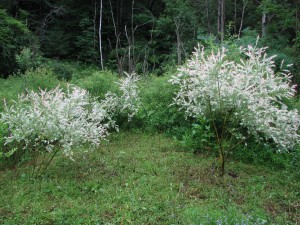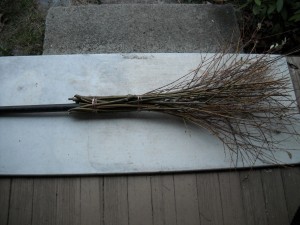Pruning Shrubs and Hardwoods
Winter is upon us. Several nights the temperatures have gone to 20 or colder at my house, and snow is in the forecast. Is it time to hibernate? Not for me, or at least not yet. I still have pruning to do. Pruning of shrubs and hardwoods like maples and oaks is best done after leaf drop when one can really see form and structure without the clutter of leaves.
Early spring blooming shrubs like forsythia, lilac, rhododendron, common ninebark and azaleas have already formed buds for next spring, and pruning will remove some. They are best pruned right after blooming, but if you didn’t do it then, you can do it now – I have been. Most hydrangeas, summersweet clethra and other late-summer bloomers will form buds next spring for blooming later on. To me it is more important to have trees and shrubs that look good all winter than to get every last blossom.
When pruning, remember that trees and shrubs do best when sunshine can reach every leaf. So thinning out branches is generally good. You should remove dead branches, and anything that is rubbing another branch. I like to remove the lower branches of most shrubs, and to take out any sprouts starting up from the roots in the vicinity of main stems. Branches aiming in toward the center of a shrub will just clutter it up, so, as the Red Queen said, “Off with their heads!”
I grow five or more kinds of willows. Willows do best in moist soil and full sun, but are very adaptable and will grow almost anywhere. They grow fast and are interesting, primarily, for their foliage. Only the pussywillow has flowers that matter, those great fuzzy things that sing “Spring is on the way!”
I’ve recently been pruning two kinds of willows: the rosemary willow (Salix elaeagnos) and a Japanese variegated willow, a cultivar of Salix integra called ‘Hakuru Nashiki’. In each case the willows stay shrubby, but tend to get a bit too tall for me. I like to keep them at a height of 8 feet or so, and that requires a trim every year or two. Other forms of willows will develop into trees 30 feet tall or more, such as the weeping willow. Most willows have relatively weak wood, meaning that their branches break easily in wind or ice storms.
I grow my Hakuru Nashiki willows across the stream from my vegetable garden. A small plant will get to be 10 feet tall in 3 to 5 years. They can have very dense foliage with lots of branches starting near the ground, but I like to see some bare stem, so I prune off all the branches up to a height of 5 feet or so. You could prune them into a lollipop shape by removing all but one stem, and shaping the top into a globe, though I haven’t done that. Not yet, anyway.
By pruning the willows now I am making them pleasing to my eye, but also opening them up so that they will not hold a large snow mass. Any densely-growing shrub will hold snow and is more likely to lose branches if we get a heavy, wet snow.
I remember arriving in Sofia, the capital of Bulgaria, on an April day in 1982 that just happened to be a national holiday, the celebration of the Cyrillic alphabet that featured a large parade downtown. Afterwards old women dressed in black came out with twig brooms and swept the streets and sidewalks of every cigarette butt and candy wrapper dropped by the crowds. I liked those brooms – they seemed right out of a fairy tale. This year I decided to use my willow prunings to make my own twig broom.
I had an old broom so cut off the head and re-used the handle, though I could have used a sapling instead. I collected small branches from the pile I had pruned from the willows, each about 30 inches long and about the thickness of a pencil. I arranged them around the handle, overlapping the handle by a foot.
Making a twig broom really is a 2-person project, so I asked Cindy Heath to help me attach the wires. I had bought a small coil of #18 copper wire at the hardware store and cut 2 four-foot sections for fastening the twigs onto the handle. I have large hands, so it wasn’t hard to hold the twigs firmly in place while Cindy wrapped wire around them. When the wire was tightly wrapped 4 or 5 times around the handle, she twisted the two ends together tightly. Then we did it again farther down the handle, near the end of the twigs.
I like the broom for sweeping the front walk- it gets the leaves as well as bits of sand and gravel; so far it seems sturdy and I like the way it looks. So do some pruning, and if you have enough small branches, try making yourself a broom.
Visit Henry’s website (www.henryhomeyer.com) to learn about his new children’s book, Wobar and the Quest for the Magic Calumet.




